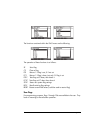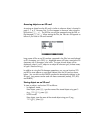
Page 26-4
Backup objects
Backup objects are used to copy data from your home directory into a memory
port. The purpose of backing up objects in memory port is to preserve the
contents of the objects for future usage. Backup objects have the following
characteristics:
Θ Backup objects can only exist in port memory (i.e., you cannot back up
an object in the HOME directory, although you can make as many
copies of it as you want)
Θ You cannot modify the contents of a backup object (you can, however,
copy it back to a directory in the HOME directory, modify it there, and
back it up again modified)
Θ You can store either a single object or an entire directory as a single
backup object. You cannot, however, create a backup object out of a
number of selected objects in a directory.
When you create a backup object in port memory, the calculator obtains a
cyclic redundancy check (CRC) or checksum value based on the binary data
contained in the object. This value is stored with the backup object, and is
used by the calculator to monitor the integrity of the backup object. When you
restore a backup object into the HOME directory, the calculator recalculates the
CRC value and compares it to the original value. If a discrepancy is noticed,
the calculator warns the user that the restored data may be corrupted.
Backing up objects in port memory
The operation of backing up an object from user memory into one of the
memory ports is similar to the operation of copying a variable from one sub-
directory to another (see details in Chapter 2). You can, for example, use the
File Manager („¡) to copy and delete backup objects as you would do
with normal calculator objects. In addition, there are specific commands for
manipulating back up objects, as described next.


















